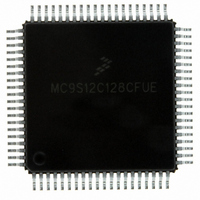MC9S12C128CFUE Freescale Semiconductor, MC9S12C128CFUE Datasheet - Page 398

MC9S12C128CFUE
Manufacturer Part Number
MC9S12C128CFUE
Description
IC MCU 128K FLASH 25MHZ 80-QFP
Manufacturer
Freescale Semiconductor
Series
HCS12r
Specifications of MC9S12C128CFUE
Core Processor
HCS12
Core Size
16-Bit
Speed
25MHz
Connectivity
CAN, EBI/EMI, SCI, SPI
Peripherals
POR, PWM, WDT
Number Of I /o
60
Program Memory Size
128KB (128K x 8)
Program Memory Type
FLASH
Ram Size
4K x 8
Voltage - Supply (vcc/vdd)
2.35 V ~ 5.5 V
Data Converters
A/D 8x10b
Oscillator Type
Internal
Operating Temperature
-40°C ~ 85°C
Package / Case
80-QFP
Cpu Family
HCS12
Device Core Size
16b
Frequency (max)
25MHz
Interface Type
CAN/SCI/SPI
Total Internal Ram Size
4KB
# I/os (max)
60
Number Of Timers - General Purpose
8
Operating Supply Voltage (typ)
2.5/5V
Operating Supply Voltage (max)
2.75/5.5V
Operating Supply Voltage (min)
2.35/2.97V
On-chip Adc
8-chx10-bit
Instruction Set Architecture
CISC
Operating Temp Range
-40C to 85C
Operating Temperature Classification
Industrial
Mounting
Surface Mount
Pin Count
80
Package Type
PQFP
Processor Series
S12C
Core
HCS12
Data Bus Width
16 bit
Data Ram Size
4000 B
Maximum Clock Frequency
25 MHz
Number Of Programmable I/os
61
Number Of Timers
1
Operating Supply Voltage
- 0.3 V to + 6.5 V
Maximum Operating Temperature
+ 85 C
Mounting Style
SMD/SMT
3rd Party Development Tools
EWHCS12
Development Tools By Supplier
M68EVB912C32EE
Minimum Operating Temperature
- 40 C
Lead Free Status / RoHS Status
Lead free / RoHS Compliant
Eeprom Size
-
Lead Free Status / Rohs Status
Compliant
Available stocks
Company
Part Number
Manufacturer
Quantity
Price
Company:
Part Number:
MC9S12C128CFUE
Manufacturer:
ST
Quantity:
6 246
Company:
Part Number:
MC9S12C128CFUE
Manufacturer:
Freescale Semiconductor
Quantity:
10 000
- Current page: 398 of 690
- Download datasheet (4Mb)
Chapter 13 Serial Communications Interface (S12SCIV2) Block Description
writing another byte to the Transmitter buffer (SCIDRH/SCIDRL), while the shift register is still shifting
out the first byte.
To initiate an SCI transmission:
Writing the TE bit from 0 to a 1 automatically loads the transmit shift register with a preamble of 10 logic
1s (if M = 0) or 11 logic 1s (if M = 1). After the preamble shifts out, control logic transfers the data from
the SCI data register into the transmit shift register. A logic 0 start bit automatically goes into the least
significant bit position of the transmit shift register. A logic 1 stop bit goes into the most significant bit
position.
Hardware supports odd or even parity. When parity is enabled, the most significant bit (msb) of the data
character is the parity bit.
The transmit data register empty flag, TDRE, in SCI status register 1 (SCISR1) becomes set when the SCI
data register transfers a byte to the transmit shift register. The TDRE flag indicates that the SCI data
register can accept new data from the internal data bus. If the transmit interrupt enable bit, TIE, in SCI
control register 2 (SCICR2) is also set, the TDRE flag generates a transmitter interrupt request.
When the transmit shift register is not transmitting a frame, the Tx output signal goes to the idle condition,
logic 1. If at any time software clears the TE bit in SCI control register 2 (SCICR2), the transmitter enable
signal goes low and the transmit signal goes idle.
398
1. Configure the SCI:
2. Transmit Procedure for Each Byte:
3. Repeat step 2 for each subsequent transmission.
a) Select a baud rate. Write this value to the SCI baud registers (SCIBDH/L) to begin the baud
b) Write to SCICR1 to configure word length, parity, and other configuration bits
c) Enable the transmitter, interrupts, receive, and wake up as required, by writing to the SCICR2
a. Poll the TDRE flag by reading the SCISR1 or responding to the TDRE interrupt. Keep in mind
d) If the TDRE flag is set, write the data to be transmitted to SCIDRH/L, where the ninth bit is
rate generator. Remember that the baud rate generator is disabled when the baud rate is zero.
Writing to the SCIBDH has no effect without also writing to SCIBDL.
(LOOPS,RSRC,M,WAKE,ILT,PE,PT).
register bits (TIE,TCIE,RIE,ILIE,TE,RE,RWU,SBK). A preamble or idle character will now
be shifted out of the transmitter shift register.
that the TDRE bit resets to one.
written to the T8 bit in SCIDRH if the SCI is in 9-bit data format. A new transmission will not
result until the TDRE flag has been cleared.
The TDRE flag is set when the shift register is loaded with the next data to
be transmitted from SCIDRH/L, which happens, generally speaking, a little
over half-way through the stop bit of the previous frame. Specifically, this
transfer occurs 9/16ths of a bit time AFTER the start of the stop bit of the
previous frame.
MC9S12C-Family / MC9S12GC-Family
Rev 01.24
NOTE
Freescale Semiconductor
Related parts for MC9S12C128CFUE
Image
Part Number
Description
Manufacturer
Datasheet
Request
R
Part Number:
Description:
Manufacturer:
Freescale Semiconductor, Inc
Datasheet:
Part Number:
Description:
Manufacturer:
Freescale Semiconductor, Inc
Datasheet:
Part Number:
Description:
Manufacturer:
Freescale Semiconductor, Inc
Datasheet:
Part Number:
Description:
Manufacturer:
Freescale Semiconductor, Inc
Datasheet:
Part Number:
Description:
Manufacturer:
Freescale Semiconductor, Inc
Datasheet:
Part Number:
Description:
Manufacturer:
Freescale Semiconductor, Inc
Datasheet:
Part Number:
Description:
Manufacturer:
Freescale Semiconductor, Inc
Datasheet:
Part Number:
Description:
Manufacturer:
Freescale Semiconductor, Inc
Datasheet:
Part Number:
Description:
Manufacturer:
Freescale Semiconductor, Inc
Datasheet:
Part Number:
Description:
Manufacturer:
Freescale Semiconductor, Inc
Datasheet:
Part Number:
Description:
Manufacturer:
Freescale Semiconductor, Inc
Datasheet:
Part Number:
Description:
Manufacturer:
Freescale Semiconductor, Inc
Datasheet:
Part Number:
Description:
Manufacturer:
Freescale Semiconductor, Inc
Datasheet:
Part Number:
Description:
Manufacturer:
Freescale Semiconductor, Inc
Datasheet:
Part Number:
Description:
Manufacturer:
Freescale Semiconductor, Inc
Datasheet:











